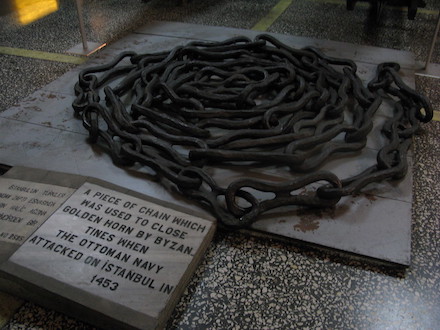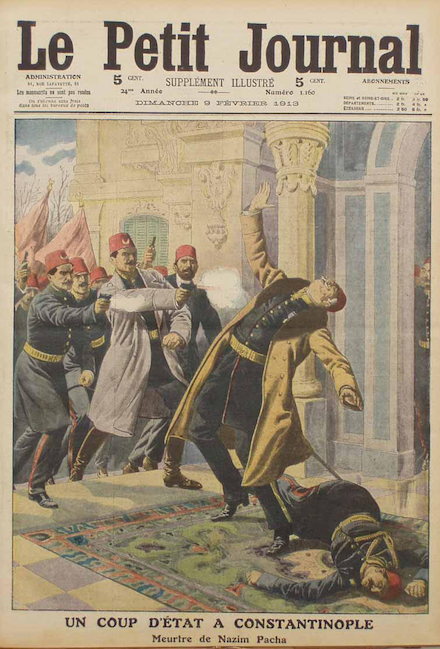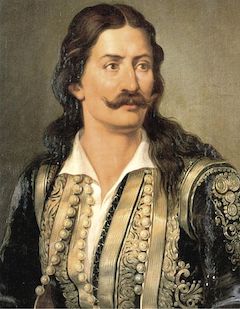From Charles Stanton in Medieval Maritime Warfare:
In the months preceding the final fall of Constantinople in 1453, the great Ottoman sultan Mehmed (II), the Conqueror, caused to be constructed in less than twenty weeks on the European bank of the Bosporus just north of the city a colossal castle which he called Bas-kesen, meaning ‘Decapitator’ or ‘Throat-cutter’. Later called Rumeli Hisar (‘Castle of the Roman Lands’), it stood opposite the Anadolu Hisar (‘Castle of Anatolia’), built in 1394 by his great-grandfather Bayezit I at the narrowest part of the strait (less than 1km across). It consisted of three main towers and fourteen smaller ones connected by inner and outer curtain walls, covering an area of 31,250 sq. m (almost 7.75 acres). The fortress still stands to this day, glowering down upon passing maritime traffic much as it did when it was completed on 31 August 1452.
 The view from the still-standing fortress shows its commanding view over the narrow strait. (cc) image from Olga Petrovska.
The view from the still-standing fortress shows its commanding view over the narrow strait. (cc) image from Olga Petrovska.The main tower in the middle was 22m (72ft) high and 23.3m (76ft 5 in) in diameter, with 6.5m (21ft 4in) thick walls. Named the Halil Pasha after the sultan’s vizier who built it, it stood closest to the shoreline. On it, Mehmed had positioned what were described as ‘bronze tubes capable of discharging balls weighing over six hundred pounds’. He then gave the citadel’s commander, one Firuz Aga, the following explicit instructions:
Do not allow ships sailing from the Hellespont [Dardanelles] to the Black Sea or from the Black Sea to the Hellespont, no matter under whose flag they may be sailing — Genoese, Venetian, Constantinopolitan, Kaffatinian, Trapezundian, Amisinian, Sinopean, or even under my own flag, and no matter what class they are — triremes, biremes, barques, or skiffs — to sail through without first lowering their sails and paying the customs duties; only after they have done so will you permit them to proceed on their way. Use the cannon to sink the ship that does not comply and submit.
Early the following November two Venetian ships destined for the Dardanelles ignored the injunction and passed through the Bosporus without stopping as ordered. Luckily, they survived the consequent cannonade. A third, carrying grain for Constantinople a short time later, was not so fortunate. The earlier experience had evidently served to provide Firuz Aga’s gunners with the proper range. A single stone from one of the cannon ‘shattered the ship’. The crew of thirty, including the captain, a certain Antonio Rizzo, were subsequently captured and taken to the sultan in Didymoteichos (in Thrace, about 37km or 23 miles south of Adrianople — modern Edirne). ‘He gave orders to behead them all except the captain whose life was to be taken by a stake through the anus,’ recorded a fifteenth-century chronicler known only as ‘Doukas’, who claimed he himself saw Rizzo’s rotting corpse only ‘a few days later’. The impact on maritime warfare was just as dramatic. The advent of a true ship-killing weapon spelled the end of one age and the beginning of another.
In his watershed study Gunpowder and Galleys, early modern military historian John Francis Guilmartin concluded that the one technological innovation most responsible for ushering in a new age of warfare was ‘the use of effective heavy cannon’. It was, therefore, fitting that Mehmed II employed perhaps the largest cannon ever built up to that point to vanquish the first great naval power of the passing medieval period. In his campaign to conquer Constantinople, the Ottoman sultan engaged a Hungarian engineer named Orban to produce a sort of supergun which could smash the several-feet thick Theodosian Walls that had protected the capital of the Eastern Roman Empire for a millennium. ‘In three months’ time a terrifying and extraordinary monster was forged,’ testified Doukas. Mehmed’s Greek biographer, Michael Kritovoulos, provided precise dimensions: the barrel was cast in bronze some 20cm (8in) thick; it measured about 8m (26ft 8in) long, with a bore at the muzzle of 76m (30in) in diameter. In a test, the cannon discharged a 544kg (1,200-pound) stone ball which burrowed itself almost 2m (6ft) into the ground over 1.6km (1m) away. Doukas said that thirty wagons pulled by sixty oxen and 200 men were required to haul it from Adrianople to Constantinople where it was positioned to batter the walls south of the Blachernae Palace.
Not content with this ostentatious display of military power, Mehmed then brought to bear the full force of his powerful new fleet. The Byzantines had barred the entrance to the Golden Horn with a giant iron chain suspended on wooden pontoons between two fortified towers, one on each side. (This chain currently resides in the Turkish Naval Museum of Istanbul.)
A squadron of ten Greek warships was stationed outside it, while another sixteen from Genoa, Venice and other western maritime cities guarded it from inside. Previous Ottoman assaults on this defensive cordon had failed, so the sultan circumvented it by building a road of greased wooden logs across Galata Hill behind the Genoese colony of Pera on the side of the Golden Horn opposite the city. He then, on 22 April, had seventy to eighty ‘biremes on wheeled cradles’ hauled over said byway and into the harbour behind the chain. The manoeuvre demoralized the defenders and enabled Mehmed’s naval forces to attack the city’s sea walls from the Golden Horn at the same time that his army assaulted the land walls. Inevitably, Constantinople fell on 29 May 1453. Vanquished were the last vestiges of Byzantine imperial power and its maritime thalassocracy remained only as a distant memory.
On this day..
- 1718: Avram Lopukhin, Peter the Great's brother-in-law
- 1905: Mary Rogers, chloroformer
- 1915: Cordella Stevenson lynched
- 1746: Charles Radclyffe, twice Jacobite rebel
- 1975: Isobel Lobato, wife of East Timor's Prime Minister
- 1934: John and Betty Stam, China missionaries
- 1922: Four anti-Treaty Irish Republicans
- Hand of Glory: 1,500 days and counting
- 2009: Yang Yanming, hedge fund manager
- 1828: Joseph Hunton, forger
- Themed Set: Reputation
- 1982: Suriname's "December murders"
- 1793: Madame du Barry, who hated to go
- 1596: Francisca Nunez de Carvajal, her children, and four other crypto-Jews of her family






 A Circassian infantryman who served under
A Circassian infantryman who served under 
 Though he acquired his nickname Diakos (“deacon”) from a youthful spell in a monastery, this fellow Athanasios (
Though he acquired his nickname Diakos (“deacon”) from a youthful spell in a monastery, this fellow Athanasios (